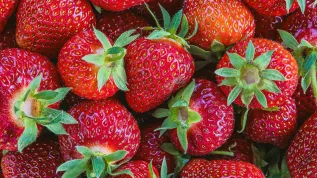
After four years the famous storks from Przygodzice have a chick at last. Chick hatched on Tuesday (7 June) in the evening - told PAP Paweł Dolata from the South Wielkopolska Group of the National Society for the Protection of Birds.
Fans of white storks from Przygodzice (watched at www.bociany.ec.pl) have been waiting for a chick for record a long time, since 2012. The waiting for the "real" inhabiting of the nest and laying eggs was also record-long.
After numerous short visits of individual storks and stork pairs (interrupted with struggles for the nest), on 2 May the nest was finally taken by a pair whose "stable" behaviour gave hope for a clutch. "The storks remained in the nest over long periods, returned on consecutive nights, and above all rebuilt it with sticks and lined with hay. The latter behaviour indicated the intention of laying eggs, for which the padding is a +feather-blanket+, and speaking professionally - +thermal insulation+"- explained Paweł Dolata from the South Wielkopolska Group of the National Society for the Protection of Birds that carries out the project" Close to Storks" in Przygodzice.
Persistent broadcast viewers finally witnessed laying eggs (6, 8 and 10 May). "Surprisingly, on May 11, only 20 hours after the previous egg, the female laid fourth egg without the shell, but then she threw it away and partly drank the contents. It can be assumed that the instinct told her that such a late brood should not be prolonged: better to settle for 3 eggs and up to 3 chicks, which would be easier to feed. Rushed breeding was also indicated by unusual start of incubation from the first egg this year. In previous years, storks usually started incubation after laying the penultimate egg. This season, parents are aware that they are literally in a race against time: the young must achieve volatility, when thermal conditions are still good to fly to the wintering grounds in Africa, that is, until August. After that, the conditions for a glider flight will be worse" - said the naturalist.
The first chick in four years hatched on Tuesday (7 June) evening, 32 days after laying the first egg.
In the seasons 2006-2012, pairs nesting on the nest always had 5 eggs (an average for storks is slightly above 4). Stork eggs weigh approx. 70-80 grams. Chicks hatch after about 33-34 days of incubation. 33 chicks hatched from the 35 eggs laid under the camera, and 20 young storks reached volatility. Unfortunately, in 2010 all five little chicks died because of downpours and cold in mid-May. In the years 2013-2015 the nest was usually occupied by a single stork and there was no offspring.
The project of website observation of white storks in Przygodzice "Close to storks" is carried out by the South Wielkopolska Group of the National Society for the Protection of Birds (www.pwg.otop.org.pl) with support of the Commune of Przygodzice and TKTelekom SA. The project started in 2006. Monitored nest is located on the chimney of the former boiler room at the Communal Office in Przygodzice since 1991.
Broadcast from Przygodzice is watched every year by hundreds of thousands of Internet users from around the world - the European countries, USA, China, but also such exotic countries as Bhutan, Equatorial Guinea, Micronesia, Central African Republic, Saint Pierre and Miquelon.
PAP - Science and Scholarship in Poland
zan/ mrt/
tr. RL













